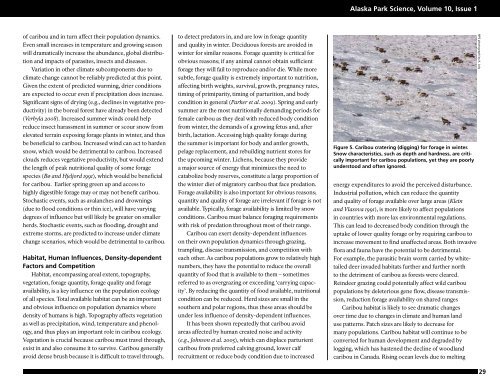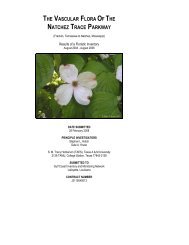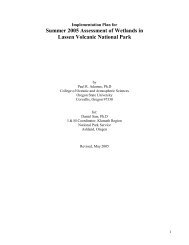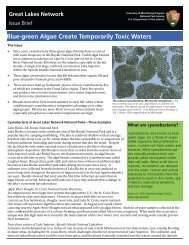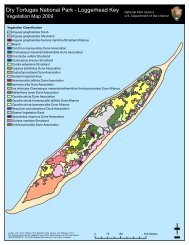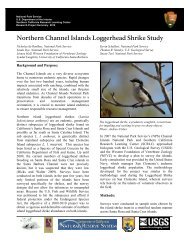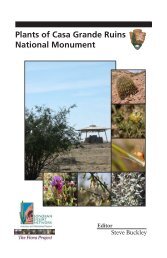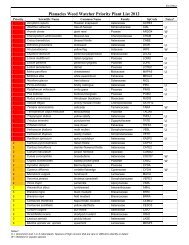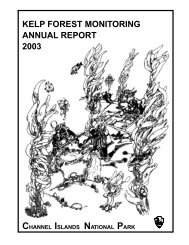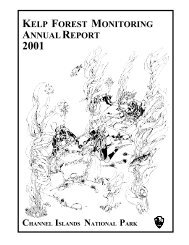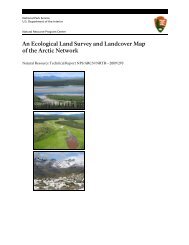Complexity of Caribou Population Dynamics in a Changing Climate
Complexity of Caribou Population Dynamics in a Changing Climate
Complexity of Caribou Population Dynamics in a Changing Climate
You also want an ePaper? Increase the reach of your titles
YUMPU automatically turns print PDFs into web optimized ePapers that Google loves.
<strong>of</strong> caribou and <strong>in</strong> turn affect their population dynamics.<br />
Even small <strong>in</strong>creases <strong>in</strong> temperature and grow<strong>in</strong>g season<br />
will dramatically <strong>in</strong>crease the abundance, global distribution<br />
and impacts <strong>of</strong> parasites, <strong>in</strong>sects and diseases.<br />
Variation <strong>in</strong> other climate subcomponents due to<br />
climate change cannot be reliably predicted at this po<strong>in</strong>t.<br />
Given the extent <strong>of</strong> predicted warm<strong>in</strong>g, drier conditions<br />
are expected to occur even if precipitation does <strong>in</strong>crease.<br />
Significant signs <strong>of</strong> dry<strong>in</strong>g (e.g., decl<strong>in</strong>es <strong>in</strong> vegetative productivity)<br />
<strong>in</strong> the boreal forest have already been detected<br />
(Verbyla 2008). Increased summer w<strong>in</strong>ds could help<br />
reduce <strong>in</strong>sect harassment <strong>in</strong> summer or scour snow from<br />
elevated terra<strong>in</strong> expos<strong>in</strong>g forage plants <strong>in</strong> w<strong>in</strong>ter, and thus<br />
be beneficial to caribou. Increased w<strong>in</strong>d can act to harden<br />
snow, which would be detrimental to caribou. Increased<br />
clouds reduces vegetative productivity, but would extend<br />
the length <strong>of</strong> peak nutritional quality <strong>of</strong> some forage<br />
species (Bø and Hjeljord 1991), which would be beneficial<br />
for caribou. Earlier spr<strong>in</strong>g green up and access to<br />
highly digestible forage may or may not benefit caribou.<br />
Stochastic events, such as avalanches and drown<strong>in</strong>gs<br />
(due to flood conditions or th<strong>in</strong> ice), will have vary<strong>in</strong>g<br />
degrees <strong>of</strong> <strong>in</strong>fluence but will likely be greater on smaller<br />
herds. Stochastic events, such as flood<strong>in</strong>g, drought and<br />
extreme storms, are predicted to <strong>in</strong>crease under climate<br />
change scenarios, which would be detrimental to caribou.<br />
Habitat, Human Influences, Density-dependent<br />
Factors and Competition<br />
Habitat, encompass<strong>in</strong>g areal extent, topography,<br />
vegetation, forage quantity, forage quality and forage<br />
availability, is a key <strong>in</strong>fluence on the population ecology<br />
<strong>of</strong> all species. Total available habitat can be an important<br />
and obvious <strong>in</strong>fluence on population dynamics where<br />
density <strong>of</strong> humans is high. Topography affects vegetation<br />
as well as precipitation, w<strong>in</strong>d, temperature and phenology,<br />
and thus plays an important role <strong>in</strong> caribou ecology.<br />
Vegetation is crucial because caribou must travel through,<br />
exist <strong>in</strong> and also consume it to survive. <strong>Caribou</strong> generally<br />
avoid dense brush because it is difficult to travel through,<br />
to detect predators <strong>in</strong>, and are low <strong>in</strong> forage quantity<br />
and quality <strong>in</strong> w<strong>in</strong>ter. Deciduous forests are avoided <strong>in</strong><br />
w<strong>in</strong>ter for similar reasons. Forage quantity is critical for<br />
obvious reasons; if any animal cannot obta<strong>in</strong> sufficient<br />
forage they will fail to reproduce and/or die. While more<br />
subtle, forage quality is extremely important to nutrition,<br />
affect<strong>in</strong>g birth weights, survival, growth, pregnancy rates,<br />
tim<strong>in</strong>g <strong>of</strong> primiparity, tim<strong>in</strong>g <strong>of</strong> parturition, and body<br />
condition <strong>in</strong> general (Parker et al. 2009). Spr<strong>in</strong>g and early<br />
summer are the most nutritionally demand<strong>in</strong>g periods for<br />
female caribou as they deal with reduced body condition<br />
from w<strong>in</strong>ter, the demands <strong>of</strong> a grow<strong>in</strong>g fetus and, after<br />
birth, lactation. Access<strong>in</strong>g high quality forage dur<strong>in</strong>g<br />
the summer is important for body and antler growth,<br />
pelage replacement, and rebuild<strong>in</strong>g nutrient stores for<br />
the upcom<strong>in</strong>g w<strong>in</strong>ter. Lichens, because they provide<br />
a major source <strong>of</strong> energy that m<strong>in</strong>imizes the need to<br />
catabolize body reserves, constitute a large proportion <strong>of</strong><br />
the w<strong>in</strong>ter diet <strong>of</strong> migratory caribou that face predation.<br />
Forage availability is also important for obvious reasons;<br />
quantity and quality <strong>of</strong> forage are irrelevant if forage is not<br />
available. Typically, forage availability is limited by snow<br />
conditions. <strong>Caribou</strong> must balance forag<strong>in</strong>g requirements<br />
with risk <strong>of</strong> predation throughout most <strong>of</strong> their range.<br />
<strong>Caribou</strong> can exert density-dependent <strong>in</strong>fluences<br />
on their own population dynamics through graz<strong>in</strong>g,<br />
trampl<strong>in</strong>g, disease transmission, and competition with<br />
each other. As caribou populations grow to relatively high<br />
numbers, they have the potential to reduce the overall<br />
quantity <strong>of</strong> food that is available to them – sometimes<br />
referred to as overgraz<strong>in</strong>g or exceed<strong>in</strong>g ‘carry<strong>in</strong>g capacity’.<br />
By reduc<strong>in</strong>g the quantity <strong>of</strong> food available, nutritional<br />
condition can be reduced. Herd sizes are small <strong>in</strong> the<br />
southern and polar regions, thus these areas should be<br />
under less <strong>in</strong>fluence <strong>of</strong> density-dependent <strong>in</strong>fluences.<br />
It has been shown repeatedly that caribou avoid<br />
areas affected by human created noise and activity<br />
(e.g., Johnson et al. 2005), which can displace parturient<br />
caribou from preferred calv<strong>in</strong>g ground, lower calf<br />
recruitment or reduce body condition due to <strong>in</strong>creased<br />
Alaska Park Science, Volume 10, Issue 1<br />
Figure 5. <strong>Caribou</strong> crater<strong>in</strong>g (digg<strong>in</strong>g) for forage <strong>in</strong> w<strong>in</strong>ter.<br />
Snow characteristics, such as depth and hardness, are critically<br />
important for caribou populations, yet they are poorly<br />
understood and <strong>of</strong>ten ignored.<br />
energy expenditures to avoid the perceived disturbance.<br />
Industrial pollution, which can reduce the quantity<br />
and quality <strong>of</strong> forage available over large areas (Kle<strong>in</strong><br />
and Vlasova 1991), is more likely to affect populations<br />
<strong>in</strong> countries with more lax environmental regulations.<br />
This can lead to decreased body condition through the<br />
uptake <strong>of</strong> lower quality forage or by requir<strong>in</strong>g caribou to<br />
<strong>in</strong>crease movement to f<strong>in</strong>d unaffected areas. Both <strong>in</strong>vasive<br />
flora and fauna have the potential to be detrimental.<br />
For example, the parasitic bra<strong>in</strong> worm carried by whitetailed<br />
deer <strong>in</strong>vaded habitats further and further north<br />
to the detriment <strong>of</strong> caribou as forests were cleared.<br />
Re<strong>in</strong>deer graz<strong>in</strong>g could potentially affect wild caribou<br />
populations by deleterious gene flow, disease transmission,<br />
reduction forage availability on shared ranges<br />
<strong>Caribou</strong> habitat is likely to see dramatic changes<br />
over time due to changes <strong>in</strong> climate and human land<br />
use patterns. Patch sizes are likely to decrease for<br />
many populations. <strong>Caribou</strong> habitat will cont<strong>in</strong>ue to be<br />
converted for human development and degraded by<br />
logg<strong>in</strong>g, which has hastened the decl<strong>in</strong>e <strong>of</strong> woodland<br />
caribou <strong>in</strong> Canada. Ris<strong>in</strong>g ocean levels due to melt<strong>in</strong>g<br />
NPS photograph by K. Joly<br />
29


